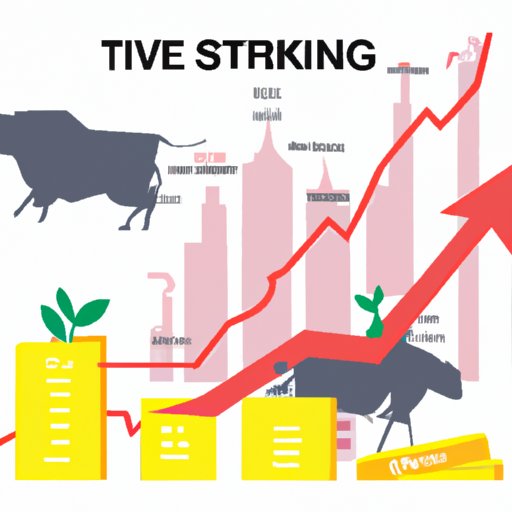Introduction
Investing in stocks is a popular way to grow your wealth and save for retirement. But how much should you invest in stocks? To answer this question, let’s first define what stock investing is. Stock investing is the process of buying and selling stocks, or shares of ownership, in publicly traded companies. Investors who purchase stocks are betting that their value will increase over time, allowing them to make a profit from their investments.
The purpose of this article is to provide an overview of stock investing and help readers understand how much they should consider investing in stocks. We’ll analyze the risks and rewards associated with stock investing, create a financial plan to determine how much to invest, explore different investment strategies, and assess your financial goals and risk tolerance for stock investing.
Analyzing Risk vs. Reward of Investing in Stocks
When considering stock investing, it’s important to understand the risks involved. Stocks can be volatile and may lose value, so there’s always a chance that investors could lose money. There are several types of risks associated with stock investing, including market risk (the risk of the overall market declining), sector risk (the risk of investing in a particular sector such as technology or oil & gas), and company-specific risk (the risk of investing in a particular company).
Despite the risks involved, there’s also potential for reward when investing in stocks. According to a study by the New York Stock Exchange, “over the long term, stocks have historically outperformed other asset classes such as bonds and cash.” This means that if you’re willing to take the risk, you can potentially get a higher return on your investments than if you chose a less risky option such as bonds or cash.

Creating a Financial Plan to Determine How Much to Invest in Stocks
Before you start investing in stocks, it’s important to create a financial plan. This will help you determine how much you should invest in stocks and ensure that you’re making wise decisions with your money. The first step is to set financial goals. Think about what you want to achieve with your investments and how much money you need to reach those goals. Once you have a goal in mind, you can calculate how much you need to invest to reach it.
Next, you’ll need to assess the resources you have available for investing. Consider your income, savings, and any other sources of money you have access to. You should also look at your current expenses and debts to make sure you have enough money to cover them before investing any extra money in stocks.

Exploring Different Investment Strategies for Stock Investing
Once you’ve created a financial plan and determined how much you can afford to invest in stocks, you’ll need to decide which investment strategy is right for you. There are two main approaches to stock investing: active investing and passive investing. Active investors actively buy and sell stocks, while passive investors focus on longer-term investments and hold onto stocks for extended periods of time. Depending on your goals and risk tolerance, one approach may be better suited to you than the other.
If you’re an active investor, you’ll need to do research and monitor individual stocks to identify good buying opportunities. If you’re a passive investor, you may want to consider investing in exchange-traded funds (ETFs) or mutual funds, which allow you to buy a portfolio of stocks without having to select each one individually.
Examining the Pros and Cons of Investing in Stocks
It’s important to understand the advantages and disadvantages of investing in stocks before committing to any particular investment strategy. On the plus side, stocks have the potential to generate significant returns over time. They also offer diversification, since you can spread your investments across multiple stocks and industries. In addition, you have the flexibility to buy and sell stocks as needed.
On the downside, stocks can be volatile and may lose value quickly. They also require careful research and monitoring to be successful. Additionally, stock investing can be costly due to trading fees and taxes.

Assessing Your Financial Goals and Investment Risk Tolerance for Stock Investing
The final step in deciding how much to invest in stocks is assessing your financial goals and risk tolerance. Start by determining your financial goals and how much you need to invest to reach them. Then, consider your risk tolerance and decide whether you’re comfortable taking on the risks associated with stock investing. Finally, choose an appropriate investment method based on your goals and risk tolerance.
Conclusion
Investing in stocks can be a great way to grow your wealth and save for retirement. However, it’s important to understand the risks and rewards associated with stock investing, create a financial plan to determine how much to invest, and assess your financial goals and risk tolerance before investing. With the right strategy and a willingness to take on some risk, stock investing can be a rewarding experience.
(Note: Is this article not meeting your expectations? Do you have knowledge or insights to share? Unlock new opportunities and expand your reach by joining our authors team. Click Registration to join us and share your expertise with our readers.)
